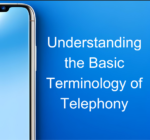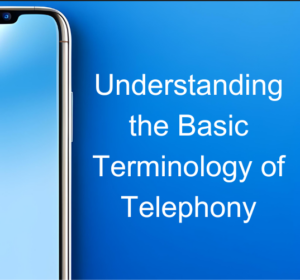Understanding the Basic Terminology of Telephony

 Telephony, also known as voice communication technology, has evolved significantly over the years. From traditional landlines to modern VoIP systems, telephony has come a long way. In order to fully understand and make the most of telephony technology, it is important to have a basic understanding of the key terms and concepts.
Telephony, also known as voice communication technology, has evolved significantly over the years. From traditional landlines to modern VoIP systems, telephony has come a long way. In order to fully understand and make the most of telephony technology, it is important to have a basic understanding of the key terms and concepts.
What is a PBX?
PBX stands for Private Branch Exchange, which is a telephone system used within a private organization to manage incoming and outgoing calls. PBXs were traditionally hardware-based systems installed on-premises, but now, they can also be software-based and hosted in the cloud. PBXs route calls within a private network, allowing users to make calls to external numbers and manage incoming calls with features such as call transfer, voicemail, auto-attendant, and call forwarding. PBXs can also provide cost savings by reducing the number of required telephone lines and providing advanced communication features to the users. In IP telephony, PBXs are often replaced by IP PBXs, which use Internet Protocol (IP) to route calls and provide advanced communication features over IP networks.
What is IP Telephony?
IP Telephony refers to a communication system that uses Internet Protocol (IP) to transmit voice, fax, and other forms of communication over a network, typically the Internet, instead of using traditional public switched telephone network (PSTN) lines. It allows users to make and receive calls using an IP phone, softphone, or smartphone, using a VoIP (Voice over Internet Protocol) service.
What is VOIP?
VOIP stands for Voice over Internet Protocol, which is a technology that allows making voice calls over the Internet. Instead of transmitting voice signals over traditional PSTN networks, VOIP converts analog voice signals into digital data packets that are transmitted over the Internet or other IP-based networks. This allows for low-cost or free communication over the Internet, and the use of advanced features such as video conferencing and call forwarding.
What is a PSTN?
PSTN stands for Public Switched Telephone Network, which is the traditional analog telephone network used for voice communication. PSTN is a circuit-switched network that routes telephone calls through a series of interconnected switches, allowing people to make voice calls over a wide area. PSTN uses copper wires and analog signals to transmit voice and was the primary means of communication before the widespread adoption of the internet and IP-based communication systems. PSTN still exists and is widely used in many parts of the world, but its use is declining with the rise of IP-based communication systems, such as Voice over IP (VoIP).
What is RTP?
RTP stands for Real-time Transport Protocol, a standard protocol for transporting real-time data, such as audio and video, over the internet or other IP networks. RTP provides end-to-end network transport functions suitable for applications transmitting real-time data, such as audio, video or simulation data, over multicast or unicast network services. RTP does not provide guaranteed delivery, but instead focuses on timely delivery of data, making it a suitable choice for real-time multimedia applications. RTP runs on top of the User Datagram Protocol (UDP) and provides sequence numbering, time stamping, and delivery monitoring to ensure timely and accurate delivery of real-time data over IP networks.
What is DECT?
DECT stands for Digital Enhanced Cordless Telecommunications, which is a standard for wireless communication used for voice and data transmission between portable telephones and a base station. DECT is a digital standard for cordless phones that provides high-quality sound, improved security, and reduced interference compared to older analog cordless phone standards. DECT provides a range of communication services, including voice telephony, voice messaging, and data services, and is widely used in residential and business environments. The technology operates in the frequency band of 1.88-1.9 GHz, and supports a large number of simultaneous calls and a wide range of telecommunication services, making it a popular choice for cordless phone systems.
What is an IP Phone?
AKA Internet Phone, SIP Phone, or VoIP Phone. An IP phone is one that converts voice into digital packets and vice versa to make phone calls over the Internet possible. It has built-in IP signaling protocols such as SIP or H.323 that ensure that the voice is routed to the right destination over the net. On the media side, the IP Phone uses audio or/and video codecs such as G.711 or/and H.261, respectively, over RTP. The IP phones come with several value-added services like voicemail, e-mail, call number blocking, etc.
What is Wi-Fi?
Wi-Fi is a technology that uses radio waves to provide wireless high-speed Internet and network connections. Wi-Fi operates in the 2.4 and 5 GHz frequency bands and uses a wireless access point (AP) to provide Internet access to devices within a defined area, such as a home, office, or public location. Devices such as laptops, smartphones, tablets, and smart home devices can connect to a Wi-Fi network by using a Wi-Fi adapter and are then able to access the Internet and communicate with each other without the need for physical cables. Wi-Fi is based on the IEEE 802.11 standards and is widely used for home and business network access as well as for providing public internet access in areas such as cafes, airports, and hotels.
What is Quality of Service?
Quality of Service (QoS) is a term used to describe the overall performance of a network in delivering data and maintaining a certain level of quality for specific applications or services. It refers to the capability of a network to provide better service to selected network traffic over various technological infrastructures, such as Ethernet or Wi-Fi. QoS aims to prioritize important network traffic, such as real-time audio and video, over less critical traffic, such as email, in order to ensure that the critical traffic is delivered effectively and with minimal delay and disruption. QoS is accomplished through a combination of hardware and software technologies, including traffic shaping, packet prioritization, and resource reservation.
What is Session Initiation Protocol (SIP)?
Session Initiation Protocol (SIP) is a signaling protocol used for initiating, maintaining, modifying, and terminating real-time sessions that involve video, voice, messaging, and other communications applications and services between two or more endpoints on IP networks. It’s a standard for initiating and terminating multimedia sessions, such as voice and video calls, over the internet or other IP networks. SIP operates at the application layer of the OSI Model and enables the creation of a multimedia session between two or more communication devices, such as IP phones, softphones, and servers.
What is SIP Trunking?
SIP Trunking is a technology that enables businesses to make and receive phone calls using their existing IP network, rather than traditional PSTN lines. SIP Trunks are virtual phone lines that are delivered over the internet, replacing the need for physical telephone lines. SIP Trunks can be used for both voice and data communications, and provide a flexible, scalable, and cost-effective alternative to traditional phone lines for businesses. SIP Trunks allow for easy integration with unified communication platforms, such as IP PBXs and cloud-based communication services, and provide advanced features such as automatic call distribution, virtual numbers, and call forwarding.
In conclusion, these are just a few of the key terms and concepts that are important to understand when it comes to telephony. Whether you are using a traditional telephone system or a modern VoIP solution, understanding the basics of telephony terminology can help you make the most of your voice communication technology.
